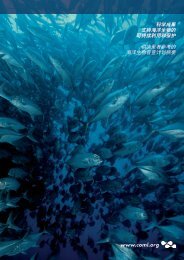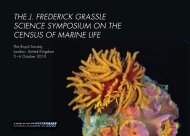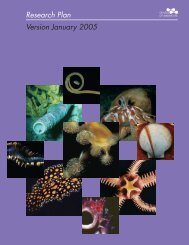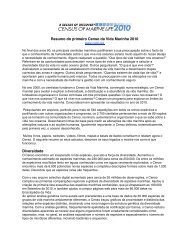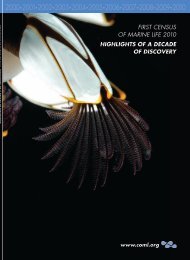Census of Marine Life Iconic Images Captions and Credits
Census of Marine Life Iconic Images Captions and Credits
Census of Marine Life Iconic Images Captions and Credits
Create successful ePaper yourself
Turn your PDF publications into a flip-book with our unique Google optimized e-Paper software.
"New" Dumbo (Grimpoteuthis sp.), a cirrate octopod,<br />
photographed over the Mid-Atlantic Ridge. Image Courtesy<br />
<strong>of</strong> David Shale<br />
Seastar along the shore <strong>of</strong> Cobscook Bay, Maine, August<br />
2007. Image Courtesy <strong>of</strong> Christina Kulfan<br />
Collected from the DIVA 2 cruise in February/March 2005 at<br />
5000m depth in the Southern Atlantic Ocean, what appears to be<br />
an ancient gold treasure is a magnified crustacean, a tiny copepod.<br />
Image Courtesy <strong>of</strong> Marco Büntzow, Paulo Corgosinho<br />
This striking creature, a Venus flytrap anemone, Actinoscyphia sp.,<br />
was photographed in the Gulf <strong>of</strong> Mexico. Photo: Ian MacDonald,<br />
Florida State University.<br />
The tube anemone, or tube dwelling anemone, lives in a mucous<br />
tube on the muddy bottoms <strong>of</strong> coastal waters, estuaries, <strong>and</strong> s<strong>of</strong>t<br />
seabeds. These attractive anemones are found in tropical <strong>and</strong><br />
subtropical waters throughout the world, where they can grow up<br />
to 15cm (6 in) across <strong>and</strong> 30cm (12 in) tall. When the anemone<br />
is threatened, the animal retracts into its tube for protection. The beautiful stinging<br />
tentacles <strong>of</strong> the tube anemone vary from a vibrant purple to a creamy brown. Credit:<br />
Karen Gowlett-Holmes








